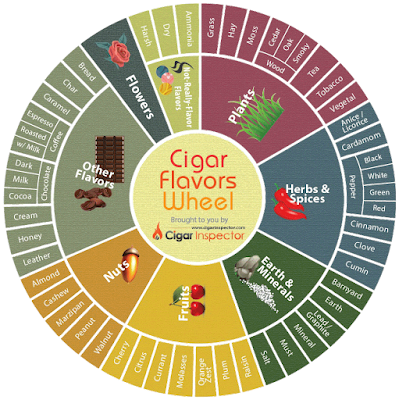There’s a good reason for grouping flavors like this: it’s relatively easy to recognize a major flavor group like “sweet” but a lot more difficult to distinguish flavors like brown sugar, molasses, maple syrup, caramel, etc. There is also a fair amount of subjectivity in describing flavors.
 |
Example of a flavor wheel. Similar approaches exist for wine, beer, whisky, etc. The ones for whisky tend to be most closely linked to the underlying chemistry. |
Rather than using the outer band of the flavor wheel, the cigar profiling method uses the inner band to denote flavors. This takes away some of the subjectivity and makes cigar profiles more easily recognizable. When writing a review and describing flavors, there’s nothing against using the outer band but for measuring and scoring purposes, the inner band is more useful.
In the cigar profiler method, I use the following ten basic flavor groups:
- Wood: cedar, oak, liquorice, resin, incense, young wood
- Earth: forest soil, dry soil, mushrooms, tobacco
- Animal: leather, barnyard, musk
- Nuts/beans: coffee, cocoa, toast, burnt, almonds, hazel nut
- Spices: green herbs, nutmeg, cinnamon, ginger
- Pepper: pepper, sharp, tingling
- Sweet: caramel, honey, sugar water, raisins, winegum
- Vegetal: grass, hay, straw, cabbage, fruity, citrus
- Cream: butter, cream, vanilla, custard
- Other: sour, bitter, metallic, mouldy, salty
Preliminary data from the test team suggests that it’s possible to distinguish different cigar types based on frequent flavor group combinations. It will be interesting to see whether this is borne out with more data.
No comments:
Post a Comment